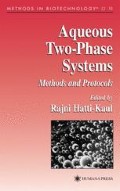Abstract
Aqueous two-phase extraction has appreciable advantages in terms of ease of scaling-up and its applicability to systems containing solids such as cell and cell debris. However, because it is not always possible to achieve an extreme partitioning of a target molecule into either phase, the introduction of an affinity ligand to the system has been examined as a means of enhancing the specificity of partitioning. Covalent binding of a ligand to a phase-constructing polymer (1–4); see also Chapters 29-31, and the use of ligand-bound chromatographic supports (5–7); see also Chapter 33 or a pH responsive polymer (8); see also Chapter 34, that partitions to the upper phase have been employed as ligand-introduction procedures. As described in Chapter 34, the method using a pH responsive polymer can realize easy recovery of the target protein as a precipitate by changing the pH after specific partitioning into upper-phase, and the ligand is also easily recovered and reused after dissociation of the target protein.
Access this chapter
Tax calculation will be finalised at checkout
Purchases are for personal use only
References
Johansson, G., Kopperschläger, G., and Albertsson, P.-Å. (1983) Affinity partitioning of phosphofruktokinase from baker’s yeast using polymer bound Cibacron Blue F3G-A. Eur. J. Biochem. 131, 589–594.
Harris, J. M. and Yalpani, M. (1985) Polymer-ligands used in affinity partitioning and their synthesis, in Partitioning in Aqueous Two-Phase Systems (Walter, H., Brooks, D. E., and Fisher, D., eds.), Academic, Orlando, FL pp. 589–626.
Andrews, B. A., Head, D. M., Dunthorne, P., and Asenjo, J. A. (1990) PEG activation and ligand binding for the affinity partitioning of proteins in aqueous two-phase systems. Biotechnol. Tech. 4, 49–54.
Plunkett, S. D. and Arnold, F. H. (1990) Metal affinity extraction of human hemoglobin in an aqueous polyethylene glycol-sodium sulfate two-phase system. Biotechnol. Tech. 4, 45–48.
Hedman, P. O. and Gustafsson, J.-G. (1984) Protein adsorbents intended for use in aqueous two-phase systems. Anal. Biochem. 138, 411–415.
Mattiasson, B. and Ling, T. G. I. (1986) Efforts to integrate affinity interactions with conventional separation technologies: Affinity partition using biospecific chromatographic particles in aqueous two-phase systems. J. Chromatogr. 376, 235–243.
Ku, C.-A. and Henry Jr, J. D. (1989) Affinity-specific protein separations using ligand-coupled particles in aqueous two-phase systems: I. Process concept and enzyme binding studies for pyruvate kinase and alcohol dehydrogenase from Sac-charomyces cerevisiae. Biotechnol. Bioeng. 33, 1081–1088.
Kamihira, M., Kaul, R., and Mattiasson, B. (1992) Purification of recombinant protein A by aqueous two-phase extraction integrated with affinity precipitation. Biotechnol. Bioeng. 40, 1381–1387.
Wikström, P., Flygare, S., Gröndalen, A., and Larsson, P.-O. (1987) Magnetic aqueous two-phase separation: a new technique to increase rate of phase-separation, using Dextran-ferrofluid or larger iron oxide particles. Anal. Biochem. 167, 331–339.
Flygare, S., Wikström, P., Johansson, F., and Larsson, P.-O. (1990) Magnetic aqueous two-phase separation in preparative applications. Enzyme Microb. Technol. 12, 95–103.
Suzuki, M., Kamihira, M., Shiraishi, T., Takeuchi, H., and Kobayashi, T. (1995) Affinity partitioning of protein A using a magnetic aqueous two-phase system. J. Ferment. Bioeng. 80, 78–84.
Nilsson, B., Abrahmsén, L., and Uhlén, M. (1985) Immobilization and purification of enzymes with staphylococcal protein A gene fusion vectors. EMBO J. 4, 1075–1080.
Author information
Authors and Affiliations
Editor information
Editors and Affiliations
Rights and permissions
Copyright information
© 2000 Humana Press Inc.
About this protocol
Cite this protocol
Kamihira, M. (2000). Affinity Partitioning Using Magnetic Two-Phase Systems. In: Hatti-Kaul, R. (eds) Aqueous Two-Phase Systems: Methods and Protocols. Methods in Biotechnology™, vol 11. Humana Press. https://doi.org/10.1385/1-59259-028-4:381
Download citation
DOI: https://doi.org/10.1385/1-59259-028-4:381
Publisher Name: Humana Press
Print ISBN: 978-0-89603-541-6
Online ISBN: 978-1-59259-028-5
eBook Packages: Springer Protocols

